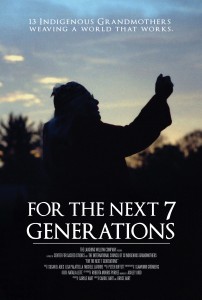 Date: Saturday, January 30th Date: Saturday, January 30th
Time: 8pm (Film runs 84 minutes)
Admission: $5
Shamanic Film Screening: FOR THE NEXT 7 GENERATIONS - The Thirteen Indigenous Grandmothers
Phantasmaphile proudly presents a screening of the film, FOR THE NEXT 7 GENERATIONS, a documentary about a group of female shamans who call themselves the Thirteen Indigenous Grandmothers.
50% of the proceeds for this screening will be donated to the International Council of Thirteen Indigenous Grandmothers
Synopsis:
In 2004, thirteen Indigenous Grandmothers from all four corners, moved by their concern for our planet, came together at a historic gathering, where they decided to form an alliance: The International Council of Thirteen Indigenous Grandmothers. This is their story. Four years in-the-making and shot on location in the Amazon rainforest, the mountains of Mexico, North America, and at a private meeting with the Dalai Lama in India, For the Next 7 Generations follows what happens when these wise women unite. Facing a world in crisis, they share with us their visions of healing and a call for change now, before it’s too late. This film documents their unparalleled journey and timely perspectives on a timeless wisdom.
Grandmother’s Mission Statement:
“We, the International Council of 13 Indigenous Grandmothers, represent a global alliance of prayer, education and healing for our Mother Earth, all her inhabitants, all the children, and for the next seven generations to come. We are deeply concerned with the unprecedented destruction of our Mother Earth and the destruction of indigenous ways of life. We believe the teachings of our ancestors will light the way through an uncertain future. We look to further our vision through the realization of projects that protect our diverse cultures: lands, medicines, language and ceremonial ways of prayer and through projects that educate and nurture our children.”
This film is being shown in conjunction with the art exhibition, VISION QUEST, up at OBSERVATORY from January 16th-February 21st.
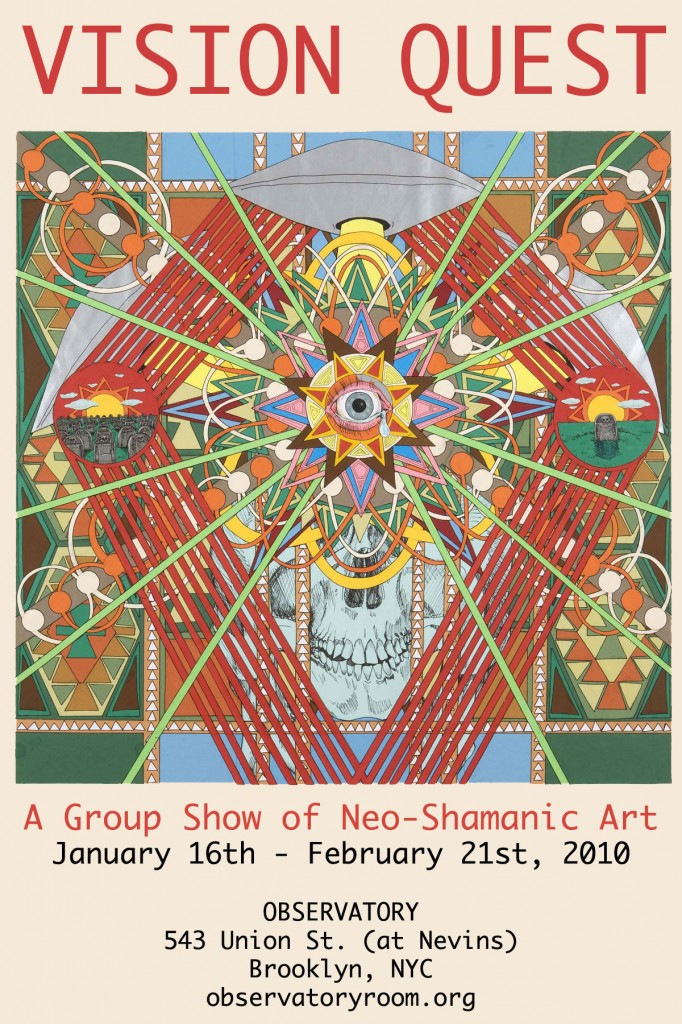
VISION QUEST – A Group Show of Neo-Shamanic Art
January 16th– February 21st, 2010
Opening: Saturday, January 16th, 2010 7-10pm
Hours: Thursdays & Fridays 3-6pm; Saturdays & Sundays 12-6pm
Click here to see images of the show
OBSERVATORY and Phantasmaphile’s Pam Grossman are proud to kick off 2010 with “VISION QUEST,” a group show of neo-shamanic art, on view from January 16th through February 21st.
A healer, a medicine (wo)man, a guide: the shaman is a figure who interfaces with nature magic and the invisible world at large, for the betterment of the tribe. Fluent in the language of symbols, and a perennial student of plant wisdom, the shaman is also a translator – bringing back messages from a place veiled thick with leaves, bones, smoke, ghosts.
This journey to the other side – to the innerside – is not just a flowery promenade of song and trance; of friendly animal spirits and ancestral reunions. For while this land is rife with vibrant, variegated beauty, it can also be a danger zone. Images of decapitation and dismemberment abound - though ultimately act as portents for personal transformation and rebirth. This shadowy terrain is trod only by those brave enough to encounter whatever may be found along the way, as each sojourn is mysterious, thoroughly unpredictable, and entirely individual. However, the results of the trip often prove invaluable, as the traveler returns armed with knowledge that will in turn illuminate and repair the community, and fortify his or her own soul.
While the role of the shaman has traditionally been fulfilled by experienced elders in indigenous groups spanning culture and time, “VISION QUEST” posits that our artists fit the bill as well. Today, with more of us living in an urban jungle rather than a real one, it has become all the more important to figure out ways to internalize the lessons of nature: its growth, its brilliant bloom, its death. And in an age of digitization and distraction, of wire vines and humming screens, it’s no wonder we long for deeper, more sensory experiences of self - with all of its darkness and divinity.
As such, each piece in “VISION QUEST” explores the archetype of the shamanic voyage, using the tools of paint, pencil, or paper in lieu of fire, flower, feather. Taken together this work represents a full spectrum of what it means to go underground and out of body; to go there and come back again, perhaps just a little bit wiser or, at the very least, more wide awake.
PARTICIPATING ARTISTS
Jesse Bransford
William Crump
Scott Gursky
Juliet Jacobson
Ashley Lande
Adela Leibowitz
Jason Leinwand
Christopher Mir
Joe Newton
Herbert Pfostl
Christopher Reiger
Christine Shields
Erika Somogyi
Jessie Rose Vala
ABOUT THE CURATOR
Pam Grossman is the creator and editor of Phantasmaphile, the premiere online destination for art aficionados with a passion for the surreal and the fantastical. An internationally beloved art and culture web log, it features daily spotlights on artists and events, as well as interviews with such visual luminaries as Thomas Woodruff, Nils Karsten, and Richard A. Kirk. Phantasmaphile was written up two years in a row on the Manhattan User’s Guide Top 400 New York Sites list, and Grossman’s previous show, “Fata Morgana: The New Female Fantastists” was featured by myriad taste-making outlets including Juxtapoz, Arthur, Upper Playground, and Neil Gaiman’s Twitter page. “VISION QUEST” is her latest curatorial effort, and she is proud to have it hanging at OBSERVATORY, the art and events space she co-founded.
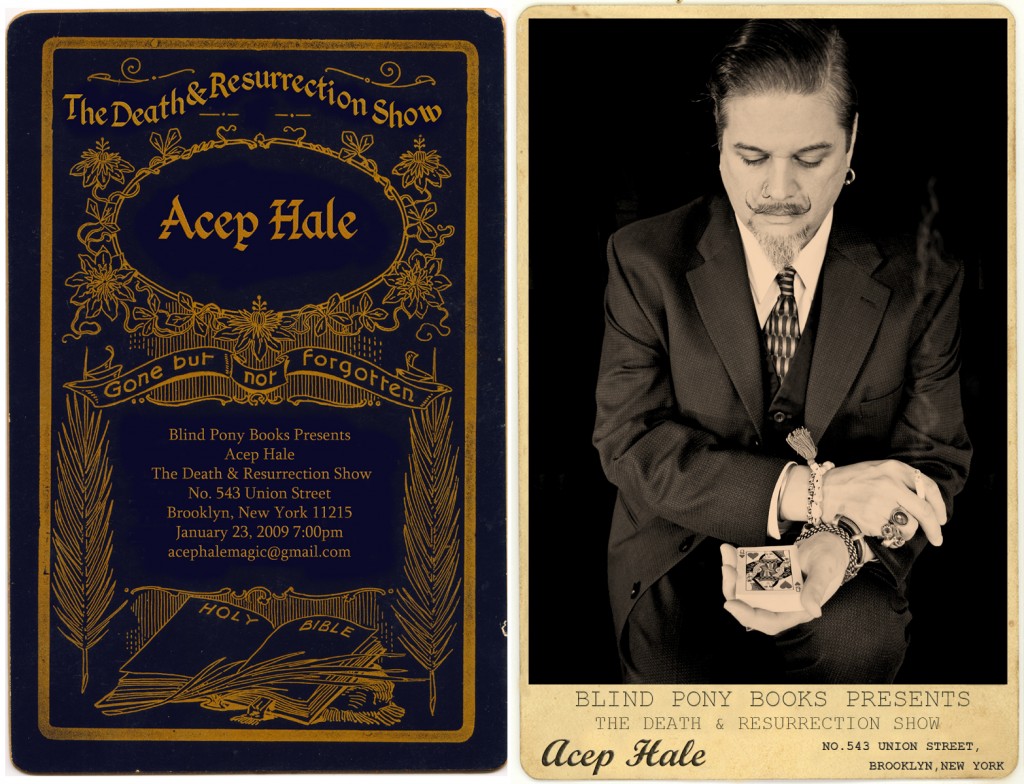 Date: Saturday, January 23
Time: 7:00
Admission: $5.00
Date: Saturday, January 23
Time: 7:00
Admission: $5.00
“There is a secret history to this world. Buried beneath the onslaught of civilization’s crushing rise to power, ancient rituals, whispered myths and the half-forgotten legends of our nomadic ancestors have always peeked through the protecting veils known as entertainment. From the first shamans making dolls dance beside a fire through the ancient courts of Egyptian pharaohs, the markets of medieval England to the dark parlors of the Fox Sisters séances , Acep Hale takes you on a guided tour of the clowns, contraries, murmurers and mystics that have held fast to lives of wandering wonder.
Acep Hale is a street performing magician, musician, traveler, and rogue gentleman scholar. Driven by the 19th century belief in propaganda by deed he performs daily on street corners everywhere to prove that magic still lives around every bend, you don’t need a nine to five to stay alive, and hope springs eternal between the cracks of every sidewalk.”
Date: Thursday, December 3rd
Time: 8:00 PM
Admission: $5
The exploding field of medical simulation inspired Justine Cooper’s Living in Sim project. Her mixed-reality artwork includes a website, online social media, photography, video and installation to explore the complexities present in the current health care environment and online social media. The project is an outcome of her artist-in-residency at the Center for Medical Simulation in Cambridge, MA from 2008-2009 along with visits to many East Coast simulation centers.
Cooper will be showing images she has taken in her journeys through many of these medical simulation centers, including images of simulations in progress, the sites where medical simulation is being utilized, mannequins she has met along the way and the characters she created for them beyond their roles as patient simulators.
The gallery show is up through the end of the year at :
Daneyal Mahmood Gallery
511 West 25th Street 3fl
New York, NY 10011
T-Sa 11-6
http://daneyalmahmood.com
website http://livinginsim.com
Bio: Sydney born, New York based artist Justine Cooper investigates the intersections between culture, science and medicine. She has been artist-in-residence at the American Museum of Natural History in New York and the Australian Key Center for Microscopy and Microanalysis. She is best known for creating the (fictional) lifestyle drug, HAVIDOL (http://havidol.com). Her work has been internationally recognized and exhibited including at The New Museum, New York; The Singapore Museum of Art; Netherlands Institute for Media Art, George Pompidou Centre, Paris; and the International Center of Photography, New York. She credits her interest in making work in science and medical institutions to the fact she grew up as the daughter of two veterinarians. As a child she lived in the back rooms of their veterinary clinic, observing and sometime assisting in examinations and surgeries.

An illustrated lecture about the history of dissection photos in America as discussed in his critically acclaimed book “Dissection: Photographs of a Rite of Passage in American Medicine 1880-1930″
By co-author and Chief Curator of the Dittrick Medical History Center James Edmonson.
Date: Sunday, December 6th
Time: 4:00 PM
Admission: $5
Books will be available for sale and signing
“The Dissection Room Photo: A Lost Genre of Medical Portraiture.”
An illustrated lecture by James Edmonson, co-author of Dissection: Photographs of a Rite of Passage in American Medicine 1880-1930 and curator of the Dittrick Medical History Center and Museum of Case Western Reserve University.
This illustrated lecture by James Edmonson, based on research and photographs presented in his critically acclaimed (Amazon top 10 science books of the year, featured in New York Times, New York Times Book Review, Slate, NPR All Things Considered, NPR Science Friday) Dissection: Photographs of a Rite of Passage in American Medicine 1880-1930, will explicate and contextualize an under-seen genre of the American photographic tradition: photographs taken of human dissections by medical students. This book, with more than 100 rare historic photos, will be available for sale and signing at the event, along with other Blast Books publications such as the 2010 Mütter Museum Calendar and books The Mütter Museum, and Mütter Museum Historic Medical Photographs.
More about the book, from the publisher’s press release:
Featuring 138 rare, historic photographs, Dissection is a “landmark book” (Ruth Richardson) that reveals a startling piece of American history, the rite of passage into the mysteries of medicine captured in photography. From the advent of photography in the nineteenth century and into the twentieth century, medical students, often in secrecy, took photographs of themselves with the cadavers that they dissected: their first patients. The photographs were made in a variety of forms, from proud class portraits to staged dark-humor scenes, from personal documentation to images reproduced on postcards sent in the mail. Poignant, strange, disturbing, and humorous, they are all compelling.
These photographs were made at a time when Victorian societal taboos against intimate knowledge of the human body were uneasily set aside for medical students in pursuit of knowledge that could be gained only in the dissecting room. “Dissection“, writes Mary Roach, “documents—in archival photographs and informed, approachable prose—a heretofore almost entirely unknown genre, the dissection photograph.” “Without looking,” writes John Harley Warner, “we cannot see an uncomfortable past and begin to understand the legacies that American doctors and patients live with today.” That uncomfortable past saw the gradual passing of state laws, from 1831 to 1947, to govern the awkward business of cadaver supply—ever inadequate—bringing an end to reliance on professional “resurrectionists,” grave robbing, and dissection as an extended punishment for murder and as a consequence of poverty.
As James Edmonson notes, “Unsettling though these images may be, they are a thread connecting us to the shared experience among medical professionals over generations. . . . As medical schools explore alternatives to human dissection, this rite of passage may disappear.” Together, the remarkable archival photographs and illuminating essays in “Dissection” present the astonishing social realities of the pursuit of medical knowledge in nineteenth- and early-twentieth-century America.
James (Jim) M. Edmonson is Chief Curator of the Dittrick Medical History Center and Museum of Case Western Reserve University. Jim is a historian of technology who always wanted to be a curator and by a quirk of fate ended up in a medical museum, the Dittrick Museum of Medical History in Cleveland, Ohio. Recent publications include American Surgical Instruments (1997) and Dissection: Photographs of a Rite of Passage in American Medicine, 1880-1930 (Blast Books, 2009). Jim has also recently opened a major permanent exhibition at the Dittrick, “Virtue, Vice, and Contraband: A History of Contraception in America,” and is working on a companion illustrated history of contraception in book form. In the medical museum field Jim has been past president of the Medical Museums Association and serves as Secretary General of the European Association of Museums of the History of Medical Sciences. He has been a consultant to the Warren Anatomical Museum of Harvard University, the New York Academy of Medicine, the Mutter Museum, and the Waring Historical Library.
Praise for the book:
“An extraordinary collection of photographs. . . . Forget the truckloads of grandiose prose that has been spun about the art and science of medicine over the centuries: one look at this picture [page 188] and you understand what it is all supposed to be about.”
—Abigail Zuger, MD, The New York Times
“This is the most extraordinary book I have ever seen [and] the perfect coffee table book for all the households where I’d most like to be invited for coffee.”
—Mary Roach, author of Stiff and Bonk
“A truly unique and important book [that] documents a period in medical education in a way that is matched by no other existing contribution.”
—Sherwin Nuland, MD, author of How We Die
 - Vintage Postcard of Krampus, the Anti-Claus. Reproduced under Fair Use provision of copyright law.
Morbid Anatomy Presents at Observatory
Date: Saturday, December 19th
Time: 8:00
Admission: $7
How the Lord of Misrule became a Bourgeois Tool (And Still Managed to Enrage the Religious Right)
An illustrated lecture with cult author and cultural critic Mark Dery
Lecture, followed by an Observatory Holiday party, complete with lovely alcoholic beverages, themed snacks, and live music as performed by Brooklyn’s own Ruprecht and The Birch Switches, who will perform your favorite Krumpus Carols.
Few Americans know that Santa descends from the mock king who held court at Saturnalia, the Roman festival celebrating the winter solstice. Or that he shares cultural DNA with the Lord of Misrule who presided over the yuletide Feast of Fools in the Middle Ages—lewd, blasphemous revels that gave vent to underclass hostility toward feudal lords and the all-powerful church.
By the late 19th century, Christmas in Manhattan was an excuse for the rabble to go wilding from door to door in upper-class neighborhoods, demanding booze and cash from terrified householders in exchange for an off-key (and sometimes off-color) yuletide song. In desperation, Washington Irving, Clement Clarke Moore, and other members of New York’s cultural elite invented Santa Claus—and Christmas as we know it—as a means of domesticating the drunken revels of the dangerous classes. Their bourgeois myth was designed to channel lumpen unrest into a more acceptable outlet: a domestic ritual consecrated to home, hearth, and conspicuous consumption.
In Satan and Santa: Separated at Birth?, Dery, a cultural critic and book author, takes a look at the Jolly Old Elf’s little-known role as poster boy for officially sanctioned eruptions of social chaos, as well as his current status as a flashpoint in “the Christmas Wars”—cultural battles between evangelicals, atheists, conservatives, and anti-consumerists over the “true” meaning of Christmas. Along the way, Dery considers New Age theories that Santa is a repressed memory of an ancient Celtic cult revolving around red-capped psychedelic mushrooms; Nazi attempts to re-imagine Christmas—a holiday consecrated to a Jewish baby, for Christ’s sake—as a pre-Christian invention of tree-worshipping German tribes, in some misty, Wagnerian past; and the suspicious similarities between Satan and Santa, connections that have fueled a cottage industry of conspiracy theories on the religious right.
Bio:
Mark Dery (markdery at verizon dot net) is a cultural critic whose byline has appeared in publications ranging from The New York Times Magazine to Rolling Stone to Salon to Cabinet, and whose lectures have taken him to Australia to Austria, Belgium to Brazil, Macedonia to Mexico, Germany to the Gowanus Canal. He has been a professor in the Department of Journalism at New York University, a Chancellor’s Distinguished Fellow at UC Irvine, and a Visiting Scholar at the American Academy in Rome.
Dery is best known for his writings on the politics of popular culture in books such as The Pyrotechnic Insanitarium: American Culture on the Brink and Escape Velocity: Cyberculture at the End of the Century.
He is widely associated with the concept of “culture jamming,” the guerrilla media criticism movement he popularized through his 1993 essay “Culture Jamming: Hacking, Slashing, and Sniping in the Empire of the Signs,” and “Afrofuturism,” a concept he introduced in his 1994 essay “Black to the Future” (included in the anthology Flame Wars: The Discourse of Cyberculture, which he edited).
He blogs at MarkDery.com.
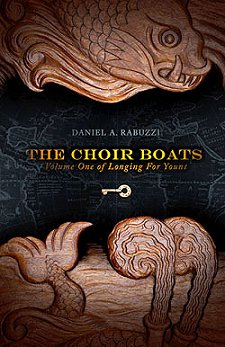 Coincident Monsters - A Conversation About Creating the Novel The Choir Boats with Daniel A. Rabuzzi and Deborah Mills Coincident Monsters - A Conversation About Creating the Novel The Choir Boats with Daniel A. Rabuzzi and Deborah Mills
Date: Friday, December 11th
Time: 8pm
Admission: $5
Carkodrillos, knife-tailed owls, knuckledogs, sea monsters and other oddities…. Join author Daniel A. Rabuzzi and illustrator Deborah Mills as they read from Daniel’s new fantasy novel The Choir Boats and display the art Deborah created to illustrate the book. Discuss with them how they collaborate (even as they remain happily married!).
The Choir Boats is a fantasy novel. If Jane Austen and J.R.R. Tolkien had hooked up, this might be their bastard offspring. In any event, The Choir Boats explores issues of race, gender, sin, and salvation, and includes a mysterious letter, knuckledogs, carkodrillos, smilax root, goat stew, and one very fierce golden cat. Deborah & Daniel will read from the novel, display artwork that inspired the illustrations, and describe how they worked together to create the overall piece– and their process as they co-create the sequel. Copies of the book will be available for sale and signing. Brought to you by Phantasmaphile.
 Wendy Walker Blue Fire Book Cover Date: Monday, December 14
Time: 8:00 pm (Doors at 7)
Admission: $5
Lecture and book-signing of her book Blue Fire; a Morbid Anatomy event presented in conjunction with Proteotypes and Proteus Gowanus
A talking tour by Wendy Walker, author of Blue Fire, a new work that reexamines the unsolved case of Constance Kent, protagonist at 15 of the Road Hill House Murder. Accused of killing her three-year-old half-brother and stuffing his body down the privy at the family estate in Wiltshire, Constance was cleared at the coroner’s inquest. In the view of many at the time, the boy had been killed by his father and his nurse, surprised in bed. Yet five years later, under the influence of a priest, Constance confessed to the crime. The “Great Crime of 1860” and the trial of Constance Kent constituted a watershed in the history of police investigation, forensic medicine, journalistic practice and and British criminal law. It caused riots in the streets and rocked the Anglican Church. It was the ancestor of the country house murder mystery and directly inspired both Wilkie Collins’ The Moonstone and Dickens’ The Mystery of Edwin Drood, as well as the first true-crime book, The Great Crime of 1860 by Joseph Stapleton. It has been novelized, dramatized, televised and filmed, and recounted from various angles, most recently by Kate Summerscale in The Suspicions of Mr Whicher (2008).
The enigmatic figure at the center of this story confessed to a crime she did not commit, was condemned to death, spent twenty years in prison, and went on to a career of almost sixty years as a nurse and social activist. This talk with images will trace the three stages of her long life.
 herbert pfostl herbert pfostl
ALL SORTS OF REMEDIES
Opening: Saturday, November 21st at 7:00pm
Exhibition: November 21, 2009 – January 8, 2010
Gallery Hours:
Thursday and Friday 3-6pm
Saturday and Sunday 12-6pm
Small paintings as parables of plants and animals and old stories of black robbers and white stags. Fragments on death like mirrors from a black sleep in the forests of fairy tales. All stories from the dust of the dead in fragments and footnotes like melodies of heartbreak and north and night and exploration–breakdowns. About saints with no promise of heaven and lost sailors forgotten and the terribly lonely bears. The unknown, the ugly – and the odd. Collected grand mistakes, noble errors from many sources. Sinking signals - conscious or not – sonatas and last letters and great insults. The impossible tears in landscapes of ocean or stranded whales. A going far back to coals and cruelties and sobbing like songs in whiskey and blood. Of soldiers’ last letters and all seven seas. With pirates and wars and prayers in holes in the ground. Of fallen women and orphaned children and drowned slaves and burned saints.
Herbert Pfostl is the author of Blind Pony Books and the Paper Graveyard, and is the buyer for the bookstore at New York’s New Museum.
Further events coinciding with ALL SORTS OF REMEDIES:
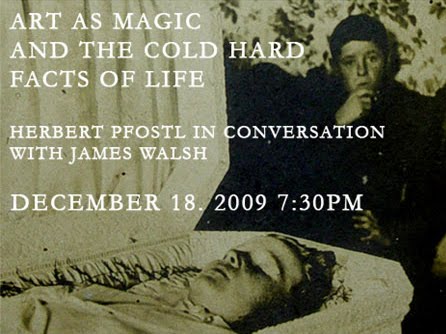

|
 Date: Saturday, January 30th
Date: Saturday, January 30th

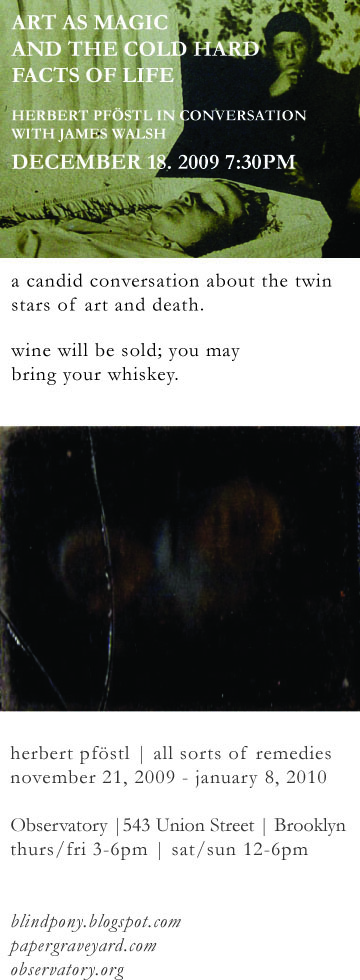
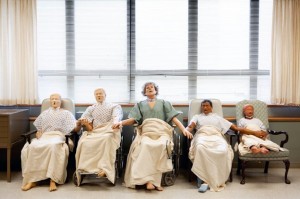


 Coincident Monsters - A Conversation About Creating the Novel
Coincident Monsters - A Conversation About Creating the Novel 
 herbert pfostl
herbert pfostl
